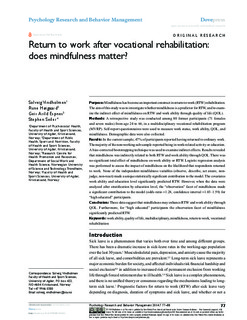| dc.contributor.author | Vindholmen, Solveig | |
| dc.contributor.author | Høigaard, Rune | |
| dc.contributor.author | Espenes, Geir Arild | |
| dc.contributor.author | Seiler, Stephen | |
| dc.date.accessioned | 2014-11-21T12:02:14Z | |
| dc.date.available | 2014-11-21T12:02:14Z | |
| dc.date.issued | 2014 | |
| dc.identifier.citation | Vindholmen, S., Høigaard, R., Espnes, G. A., & Seiler, S. (2014). Return to work after vocational rehabilitation: does mindfulness matter? Psychology Research and Behavior Management, 7, 77-88. doi: 10.2147/PRBM.S56013 | nb_NO |
| dc.identifier.issn | 1179-1578 | |
| dc.identifier.uri | http://hdl.handle.net/11250/226280 | |
| dc.description | Published version of an article from the journal: Psychology Research and Behavior Management. http://dx.doi.org/10.2147/PRBM.S56013 | nb_NO |
| dc.description.abstract | Purpose Mindfulness has become an important construct in return-to-work (RTW) rehabilitation. The aim of this study was to investigate whether mindfulness is a predictor for RTW, and to examine the indirect effect of mindfulness on RTW and work ability through quality of life (QOL). Methods A retrospective study was conducted among 80 former participants (71 females and seven males) from age 24 to 66, in a multidisciplinary vocational rehabilitation program (MVRP). Self-report questionnaires were used to measure work status, work ability, QOL, and mindfulness. Demographic data were also collected. Results In the current sample, 47% of participants reported having returned to ordinary work. The majority of the non-working sub-sample reported being in work-related activity or education. A bias-corrected bootstrapping technique was used to examine indirect effects. Results revealed that mindfulness was indirectly related to both RTW and work ability through QOL. There was no significant total effect of mindfulness on work ability or RTW. Logistic regression analysis was performed to assess the impact of mindfulness on the likelihood that respondents returned to work. None of the independent mindfulness variables (observe, describe, act aware, non-judge, non-react) made a unique statistically significant contribution to the model. The covariates work ability and education level significantly predicted RTW. However, when the data were analyzed after stratification by education level, the “observation” facet of mindfulness made a significant contribution to the model (odds ratio =1.28, confidence interval =1.03–1.59) for “high educated” participants. Conclusion These data suggest that mindfulness may enhance RTW and work ability through QOL. Furthermore, for “high educated” participants the observation facet of mindfulness significantly predicted RTW. | nb_NO |
| dc.language.iso | eng | nb_NO |
| dc.publisher | Dove press | nb_NO |
| dc.rights | Navngivelse 3.0 Norge | * |
| dc.rights.uri | http://creativecommons.org/licenses/by/3.0/no/ | * |
| dc.title | Return to work after vocational rehabilitation: Does mindfulness matter? | nb_NO |
| dc.type | Journal article | nb_NO |
| dc.type | Peer reviewed | nb_NO |
| dc.subject.nsi | VDP::Social science: 200::Psychology: 260::Social and occupational psychology: 263 | nb_NO |
| dc.source.pagenumber | 77-88 | nb_NO |
| dc.source.volume | 7 | nb_NO |
| dc.source.journal | Psychology Research and Behavior Management | nb_NO |
| dc.identifier.doi | 10.2147/PRBM.S56013 | |

